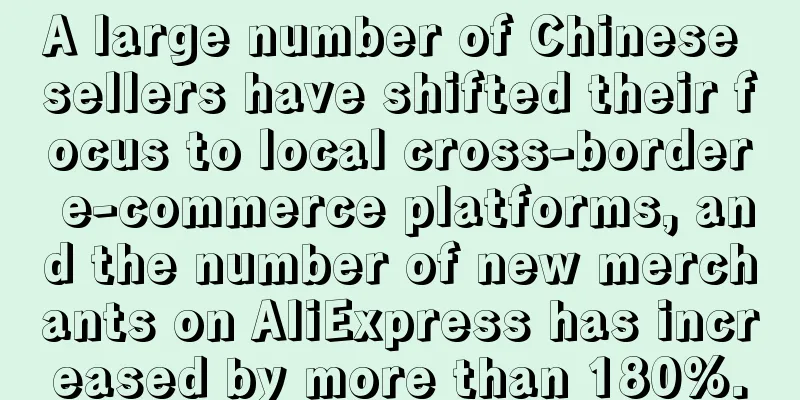Amazon’s new policy has been implemented. Are small sellers out of business?

|
Before March, few sellers thought that the warehousing configuration fee would cause such a big stir.
One week after the new fees were implemented, sellers focused on how to ship goods most cost-effectively. At the same time , the operation of using ERP to create shipments to waive the configuration fee was widely circulated, but as some sellers exposed that this had affected their performance, the industry was in doubt. In response, relevant service providers and account managers responded and advised sellers to operate with caution.
Under this wave of charges, small sellers were directly driven out of business and became the group most likely to be eliminated in this round of reshuffle. Small items, low unit prices, low turnover rates and low gross profit items were also hit. Sellers said frankly, " The real difficulty is for small sellers, with few goods and few choices, and the cost may increase several times. "
The good news is that freight forwarding companies have come up with solutions to the problem of serious warehouse division and a surge in small goods. The industry has collectively reduced the first weight and introduced the same price for large and small goods, alleviating some of the pressure on sellers.
The seller does not charge for shipment and gets the performance bonus . The manager says: This is not compliant.
Sellers estimate that the first-leg freight cost has increased by 70% after the addition of the warehousing configuration fee, and the costs of some sellers have doubled.
For example, if the seller ships 50 tons of goods per month, the previous shipping fee was 200,000 yuan. After adding the warehousing configuration fee, if only one warehouse in the East Coast is sent, the shipping fee + configuration fee will be 900,000 yuan; if it is sent to three warehouses in the West Coast, the cost will be 350,000 yuan; if it is sent to five warehouses in the West Coast, the East Coast, and the Central America, the shipping fee will be 450,000 yuan. No matter how you calculate it, the cost has skyrocketed.
The cost was too great a burden, so when sellers discovered that using ERP to create shipments could avoid configuration, this method quickly spread and many people tried it.
A seller shipped goods through ERP, but she said that soon after the operation, the store received a performance warning and the account status rating dropped to 96 points. She asked the relevant department of Amazon, and after the other party learned about her shipping method, they directly asked her to change the label and store.
The industry questioned the news, believing that it might be hype and intimidation by the relevant stakeholders, and then the seller issued the details of the performance warning. The reason for the loss of performance was that there was a violation of the inventory allocation policy. It was determined that the goods shipped did not comply with the Amazon Marketplace Web Service Application API or Selling Partner API creation rules.
Sellers were shocked to hear that ERP locks are free of charge, but may raise a red flag. Even if they have doubts, they dare not take the risk of breaking through. At the same time, some relevant service providers have stepped forward to remind sellers:
"We have just received reliable news that the goods sent by some sellers through the so-called risk-free '0 shipment configuration fee operation' on the market have begun to arrive, and performance problems have occurred in the background. So we suggest that everyone wait and see, and be cautious when trying. We are also working with the official to find a solution."
So, will there be a configuration fee for shipping using ERP? Will sellers lose performance by exploiting loopholes?
An account manager said that when sellers use ERP to ship goods, they must first go to the backend to set whether they want single-point warehouse entry or dispersed warehouse entry. The sellers understand that they do not need to pay the inbound fee, but in fact, the backend divides the goods into 4-5 warehouses according to the dispersed warehouse entry they choose, but the seller actually only chooses 1-2 of them to ship and deletes the other goods. So according to the seller’s initial settings, this does not need to be charged, but the inbound placement fee is "Amazon will charge it 45 days after receiving the goods, based on the actual warehouse entry location and received quantity", so although this fee is not displayed on the page now, it will be charged according to the actual single-point warehouse entry fee after the goods are actually warehoused.
"In summary, this is very non-compliant. Not only do they have to pay the inbound placement fee, but they also have to pay the inbound defect fee and eat into performance."
Small sellers enter the elimination zone, how to minimize delivery costs
Compared with their peers who were in a panic, some old sellers successfully avoided the first wave of impact.
Amazon had previously notified that the warehouse configuration fee would take effect in March. They calculated in advance that it was more cost-effective to ship more goods and pay more storage fees than the expensive configuration fee, so they shipped more goods in February and created a large number of shipments with Chinese addresses, in order to avoid the audit risks of creating shipments with foreign addresses and to leave enough time for March stocking. This month, they almost did not have to create any shipments, avoiding "guinea pig-style" violations or high-cost shipments, and were able to observe and study the response plan.
One week after the new policy was implemented, senior seller @跨跨小汪哥 said that the configuration fee has a great impact on all products. There is no optimal solution for current shipments, and the only way is to calculate the optimal configuration : first, the seller must have enough goods, and then get the quotation sheet to calculate each warehouse and shipping method to find the most cost-effective route. Moreover, the routes suitable for different types of goods may be completely different, which is a very tedious task.
"The real difficulty lies with small sellers, who have few products and few choices, so they have no chance to find the best solution, and their costs may even increase several times."
Small sellers have become the most vulnerable group to be eliminated in this round of reshuffle. A big seller in the kitchen category revealed that after the warehouse configuration fee policy came out in early March, many companies could not bear it. One seller admitted that the newly added warehouse configuration fee is the biggest challenge he has faced in his career so far.
For big sellers, the configuration fee means an increase in workload. In the future, they will need to make several comparisons when shipping, and find the optimal solution for the first leg by comprehensively considering the cost and timeliness. Operations must be more refined. But for small sellers, it is a life-and-death elimination match. Due to insufficient cargo volume, many small sellers do not have many choices and have to go with the more expensive first leg model, which means they lose at the beginning. Due to the substantial increase in costs, small sellers are likely to be forced to raise prices first, which will further reduce the order volume and enter a vicious cycle.
Brother Wang admitted: "Although it is cruel, sufficient quantity of goods is the basis for combating a series of changes. Only with sufficient quantity of goods can there be enough opportunities to test the goods and enough opportunities to crush others in the integration of the supply chain system." Xiaomai has no advantage at all in this regard.
In addition to sellers with less volume, small items, low unit price, low turnover rate and low gross profit products are also hurt. What is the most cost-effective way to ship? After calculation, some sellers said that if the configuration fee per kilogram of the product is not high, they can consider 2-3 warehouses in the West Coast of the United States . For small products, I am afraid they can only choose 0 configuration fee warehouse.
"After calculating two bills, it is still cheaper to divide it into five warehouses. We have 10 products in one kilogram. If it is divided into 2-3 warehouses in the West Coast of the United States, the delivery fee for each product is US$0.24, and US$2.4 per kilogram is about 17.3 yuan. Add the freight, the price is ridiculously high."
Freight forwarders collectively reduce the lifting weight and promote the same price for large and small goods
The increase in warehousing configuration fees or first-leg fees is inevitable. After weighing the pros and cons, most sellers will choose to ship from separate warehouses. However, when creating shipments, many sellers do not have the option of dispersed shipments and can only ship to one warehouse, possibly because of the small shipment volume.
However, when there is only a single delivery option, the seller can report it to the manager for investigation. ASIN, box qty, units, STA workflow id, and shipment id will all affect the warehouse results. Send this information to the store 2024Q1 manager and ask him to help investigate why there is no other warehousing option. (PS: The workflow id can be viewed in the lower left corner of the Create Shipment page)
A batch of goods may be severely divided into warehouses, with the number of goods reaching 10 or even more. The consequence of widespread warehouse division is that many sellers' goods cannot reach the minimum receiving weight of 100kg, facing a sharp increase in the first-leg fee or even being unable to ship. As a result, logistics companies are also involved and collectively reduce the minimum weight.
Previously, the price of small goods was about 2 yuan higher than that of large goods over 100kg, and they had to be shipped together. At present, cross-border logistics companies have generally reduced the minimum delivery weight in the United States to 20kg, and some even offer a minimum delivery weight of 10kg. They also charge the same price for large and small goods. At the same time, they have begun to expand routes, hoping to cover more warehouses that can be delivered.
However, taking costs into consideration, some companies have lowered the minimum weight, but still charge different fees for small goods, such as 12kg+ and 51kg+ price ranges.
Jack Chen, a freight forwarder from Shenzhen , said that after comparison, many sellers still think that split warehousing is more cost-effective, so freight forwarders have to make concessions.
"The company has reduced the minimum order size for all channels to 21kg, and the price is the same for large and small goods. We have also increased the number of warehouses that can deliver goods by express delivery. After all, the price of small goods delivered by express delivery is very expensive. For the problem of express delivery, we will inform the seller in advance how long it will take to collect goods, so that the seller can have a psychological estimate. In the future, more and more goods will be sent to the warehouse, and the timeliness will only get faster and faster."
Amazon's move of charging storage fees not only kicked off a knockout round among sellers, but also accelerated the screening of logistics companies. Jack Chen lamented: "The logistics market is even more brutal this year, as can be seen from the 1kg minimum charge. The 1kg minimum charge for sea freight is a bid to snatch small package customers?" |
<<: A group of Amazon sellers were sued for infringement, involving multiple categories
>>: Facing unemployment after 6 years of experience, operations: "Black hat" has ruined me!
Recommend
The US e-commerce logistics market is growing at an astonishing rate, with profits expected to exceed $118.8 billion in 2028
With the rapid development of e-commerce, more an...
What is eBags? eBags Review, Features
eBags is the world's largest online retailer o...
Amazon updates its Account Health Rating tool
Currently, there are nearly 2 million sellers on ...
What is PRINTWAY.IO? PRINTWAY.IO Review, Features
PRINTWAY.IO is a fulfillment platform located on ...
Amazon is conducting another strict inspection and some sellers’ stores have been closed!
Recently, many sellers have received official ema...
Amazon launches new website to help sellers grow their business
Amazon US issued an announcement on December 10, ...
Take it off the shelves! A toy brand has issued a new case after three years
As a popular category on Amazon, toys have always...
With the rise of social e-commerce, Webuy is competing in Southeast Asia!
Subsequently, Webuy ’s social influence was quick...
Sun protection clothing, sun protection leg covers... There are so many new "men's sun protection" equipment on Tmall that even girls are jealous
With hot days coming, how to protect yourself fro...
The former DingTalk CEO has joined the game with capital, and cross-border e-commerce is still being pursued by capital amid the account blocking trend!
In recent years, capital has been continuously in...
Topped the Amazon category TOP 1 for two years, Shenzhen's big seller "smartly breaks into the 3C red ocean"!
On January 13, Wang Lingjun, Deputy Director of m...
Amazon warehouses are seriously overwhelmed! Are multiple warehouses closed urgently?
There are frequent problems with last-mile delive...
What is Official Lecture Hall? Official Lecture Hall Review, Features
The official lecture hall (academy) is the world&...
US court dismisses antitrust lawsuit against Amazon
It is understood that in May last year, Washingto...
What is Mengdian? Mengdian Review, Features
Mengdian is a domestic mobile social e-commerce p...









